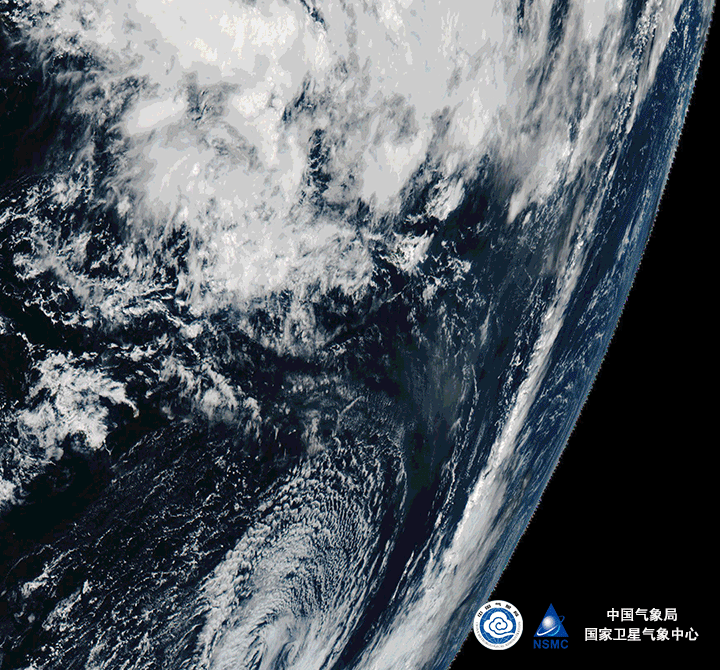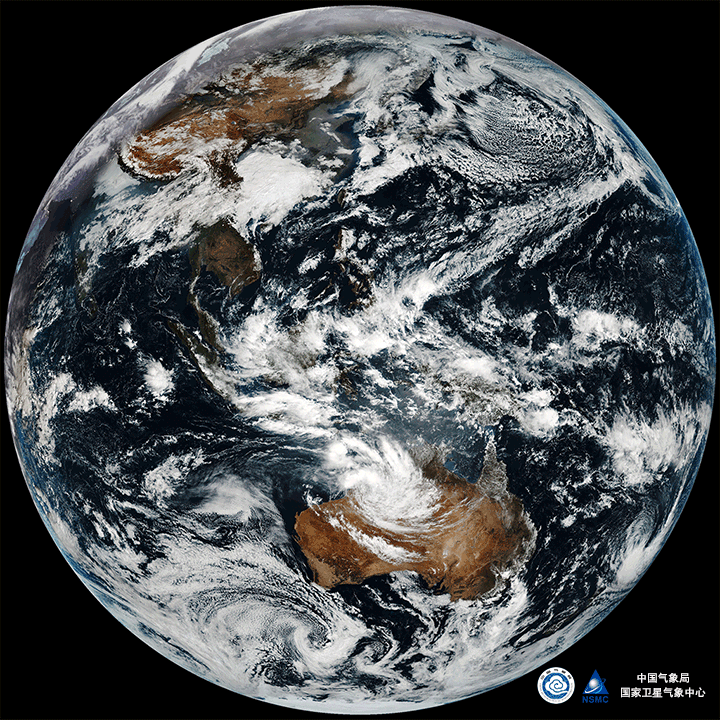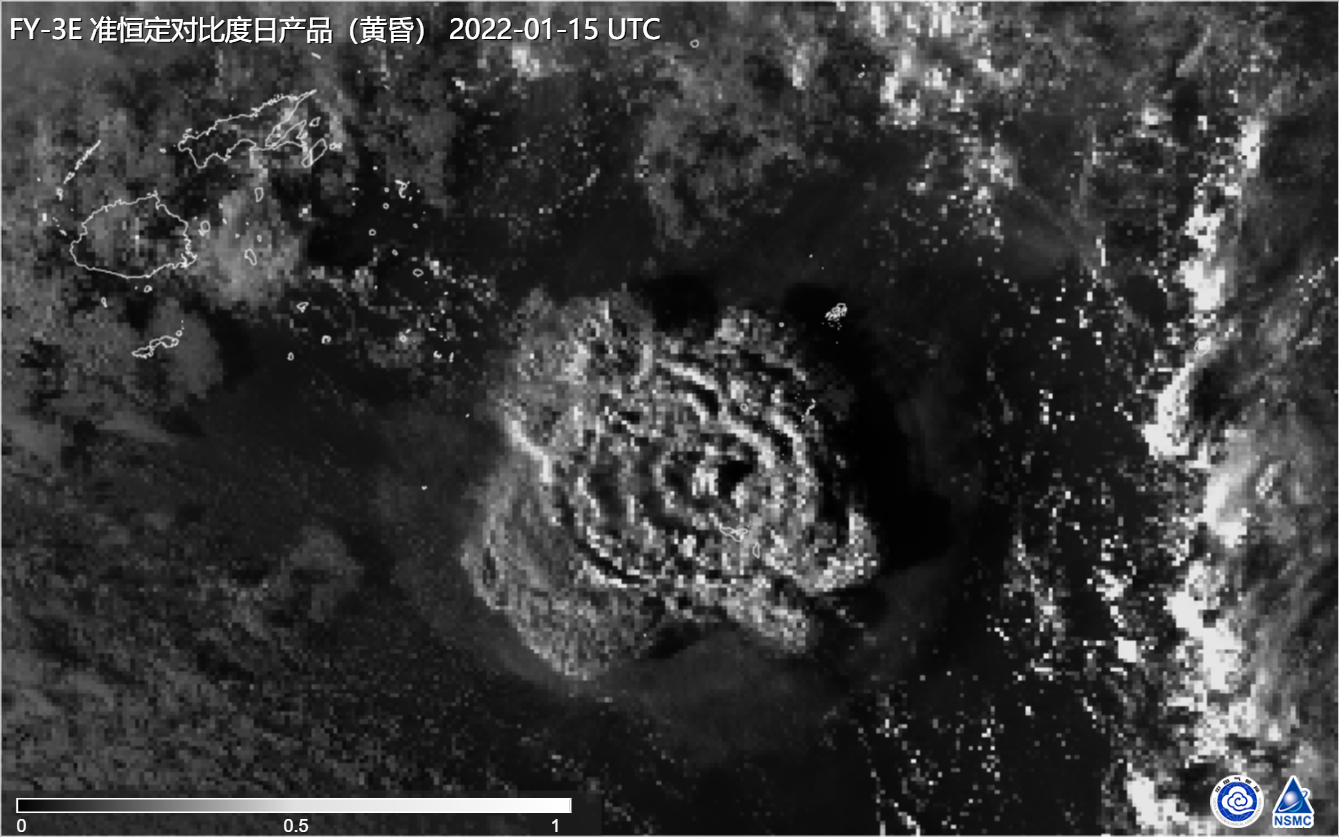A massive underwater volcano erupted in Tonga just before sunset on January 14, triggering tsunami waves around the Pacific and causing "significant damage" to the island nation's capital. The eruption is continuous, maintaining a 5-kilometer-wide column plume of ash, steam and gas rising to 18 to 20 kilometers above sea level, according to the Tonga Geological Services.
During major volcanic eruptions, large amounts of volcanic gases, aerosol droplets and ash are injected into the stratosphere, where volcanic gases like sulfur dioxide can cool the climate.
The stratosphere starts just above the troposphere – which starts at the Earth's surface and extends 8 to 14.5 kilometers – and goes 50 kilometers high. As the updraft from the Tongan eruption enters the stratosphere, it raises the question: Could the volcano eruption cool the climate?

FY-4B Satellite: Monitoring of volcanic ash cloud diffusion on Tonga's Hunga Ha'apai island, 3:45 p.m. to 9 p.m., January 15, 2022. /NSMC, CMA
FY-4B Satellite: Monitoring of volcanic ash cloud diffusion on Tonga's Hunga Ha'apai island, 3:45 p.m. to 9 p.m., January 15, 2022. /NSMC, CMA
Volcanoes are one of the two natural drivers that influence the Earth's climate in the long-term. The other is the variation in solar irradiance.
Large eruptions reduce global surface temperature for several years, decrease land precipitation, alter monsoon circulation and modify extreme precipitation, at both global and regional scales, according to the report by the Intergovernmental Panel on Climate Change (IPCC).
Sulfur dioxide from volcanic eruptions turns into sulfuric acid, which condenses rapidly in the stratosphere to form fine sulfate aerosols. The aerosols increase the reflection of radiation from the sun back into space, making it harder for the sun's energy to reach the Earth's surface, which cools the climate.
"A warming of 0.87 to 1.22 degrees Celsius cover the period 1906 to 2005 due to greenhouse gases was partially offset by a cooling of 0.54 to 0.22 degrees Celsius attributed to aerosols," according to IPCC.
The climactic eruption of Mount Pinatubo in the Philippines on June 15, 1991 was one of the largest eruptions of the 21st century and injected a 20-million-tonnes sulfur dioxide cloud into the stratosphere at an altitude of more than 32 kilometers. According to a 1998 study on the climatic implications of volcanic cooling, the sea surface temperature showed a perturbation of -0.15 to -0.3 degrees Celsius, lasting over a period of five to 20 years, depending on the sensitivity of the climate and the perturbations for land temperatures was between -0.3 to -0.5 degrees Celsius for the same period.
Could the Tongan eruption slow down global warming?

Image by FY-4B Satellite, 3:45 p.m. to 9 p.m., January 15, 2022. /NSMC, CMA
Image by FY-4B Satellite, 3:45 p.m. to 9 p.m., January 15, 2022. /NSMC, CMA
Volcanic eruptions release the greenhouse gas carbon dioxide, however, the warming effect is very small and the cooling effect caused by sulfur dioxide outweighs the warming contribution.
Volcanic carbon dioxide emissions since 1750 are at least 100 times smaller than those from fossil fuel burning, said IPCC.
"In the last 100 years, there have been three large low-latitude volcanic eruptions, which are eruptions of Mount Agung, Mount El Chichon and Mount Pinatubo. In the winter (December to February) following the eruption, temperatures were low in most parts of China except northeast China and Xinjiang Uygur Autonomous Region," said Zhu Congwen, deputy director, Institute of Climate and Climate Change, Chinese Academy of Meteorological Sciences.

Image by FY-3C/MERSI: Forming an umbrella cloud with a diameter of nearly 500 kilometers. /NSMC, CMA
Image by FY-3C/MERSI: Forming an umbrella cloud with a diameter of nearly 500 kilometers. /NSMC, CMA
"A series of studies have shown that eruptions generally have a lasting effect on global and East Asian climate over the next one to two years, with a cooling effect of around 0.3 degrees Celsius. For China, the eruption can weaken the intensity of the east Asian summer monsoon in the next year, and then lead to the southward summer rain belt," said Zhu.
"However, there is one important factor that must be taken into account to determine whether the eruption would cause global temperatures to drop: the magnitude of the eruption," he emphasized.
Images from NASA's satellite Aura show that 62 kilotons of sulfur dioxide were released on the first day of the Tongan eruption.
According to Michael Mann, professor of atmospheric science at Pennsylvania State University, has analyzed that the eruption of Mount Pinatubo, which dropped the global average temperature by 0.5 degrees Celsius, eventually released 20 million tonnes of sulfur dioxide, so Tonga eruption would need to emit more sulfur dioxide to match the cooling effects of previous eruptions.
(If you want to contribute and have specific expertise, please contact us at nature@cgtn.com.)

